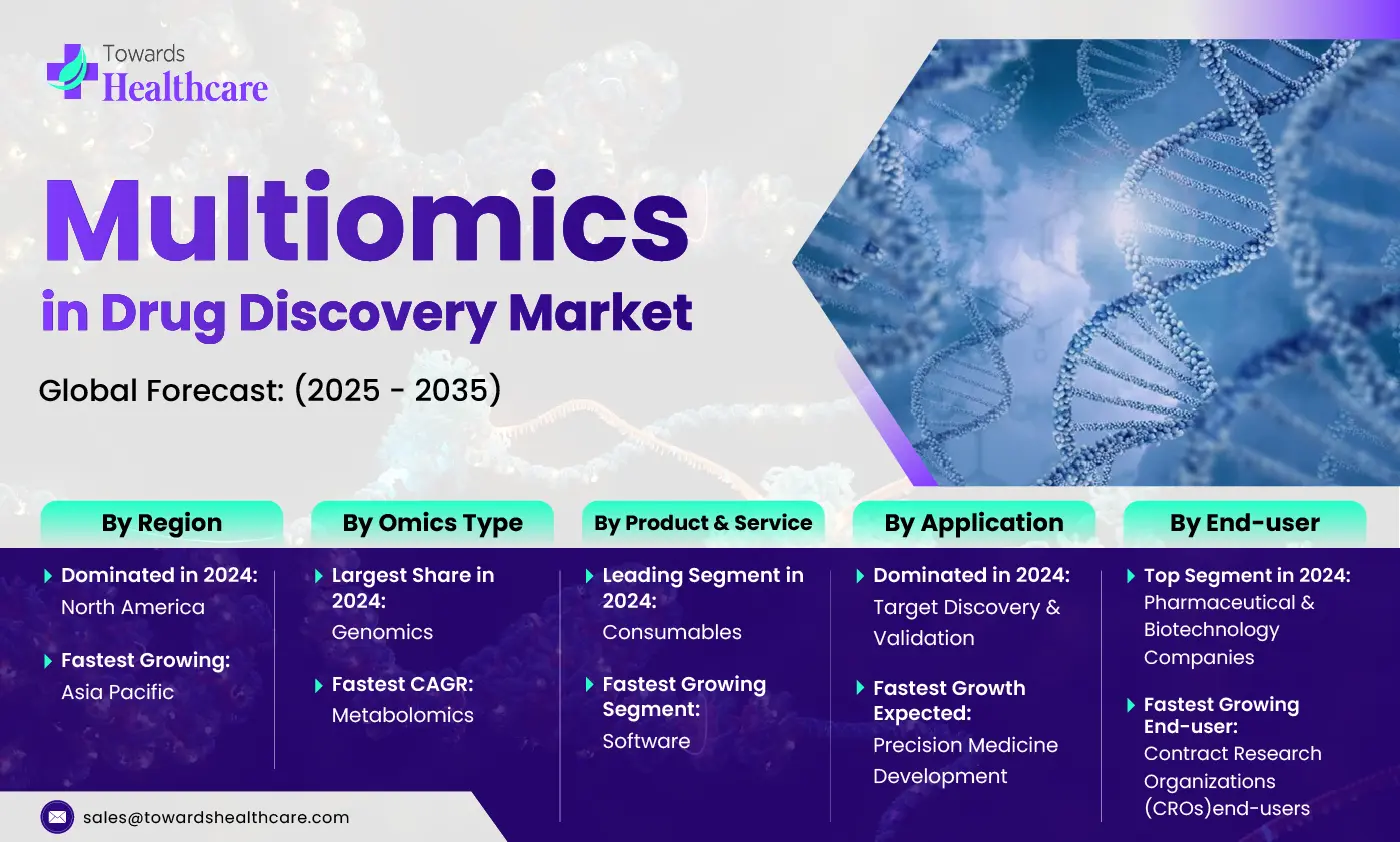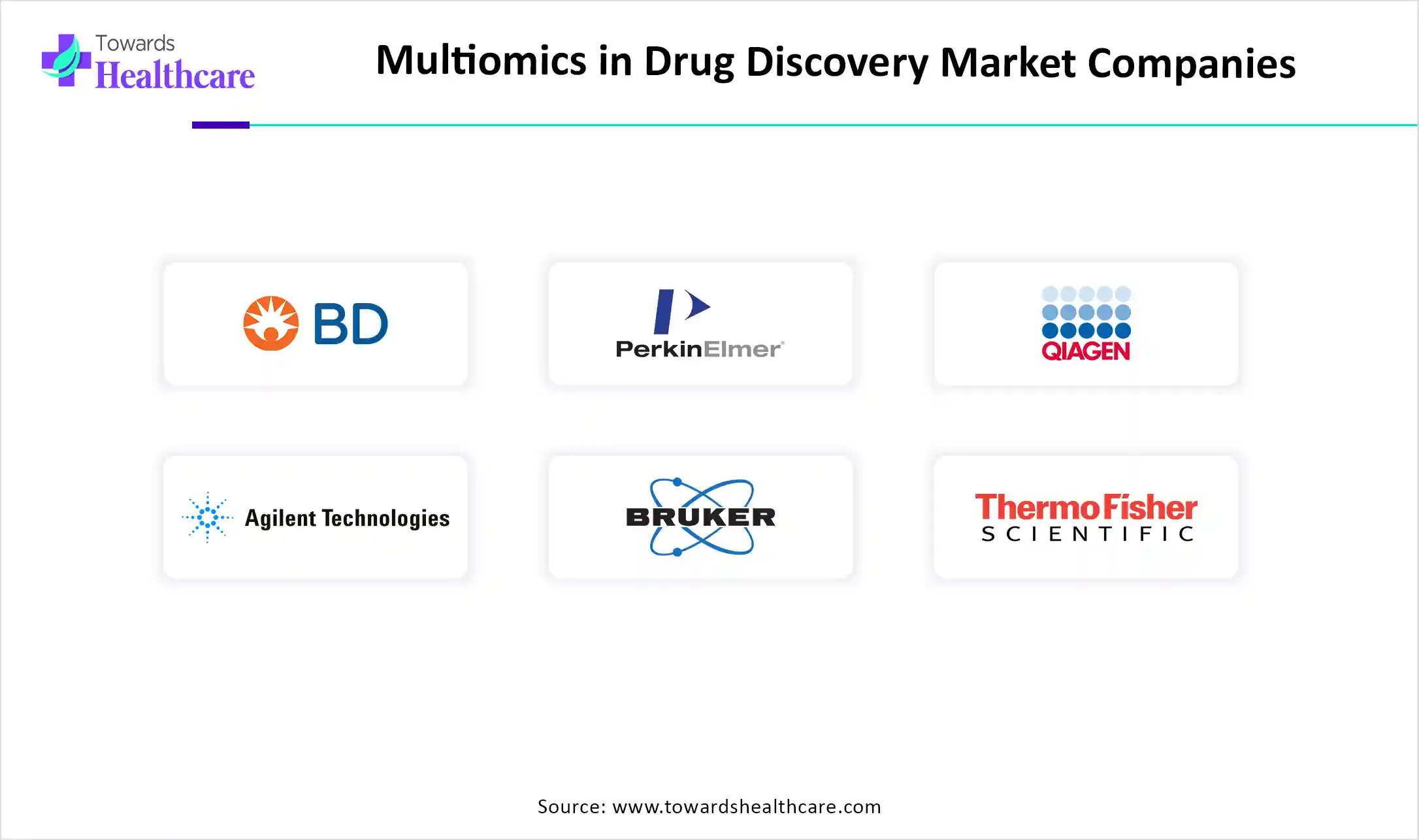December 2025

The worldwide multiomics in drug discovery market is experiencing significant expansion, with projections indicating a revenue increase reaching several hundred million dollars by the end of the forecast period, spanning 2025 to 2034. This growth is driven by emerging trends and strong demand across key sectors.
Integration of multi-omics data is emerging as a significant innovation in the rapidly evolving field of pharmaceutical research and development. One of the numerous potential uses of multi-omics in drug research is the prediction of drug sensitivity. As technology develops, multi-omics, a key area of concentration in the ongoing fight against diseases, has the potential to transform disease treatment and improve patient survival. Multi-omics applications will benefit from technological advancements, and incorporating artificial intelligence is a recent trend that necessitates international cooperation.

Drug-target identification is becoming more and more important as a crucial part of contemporary drug discovery. Additionally, the process of identifying potential therapeutic targets has made extensive use of single-omics technology. Traditional single-omics approaches are gradually being replaced by integrated multi-omics strategies in drug-target discovery as a result of the advancements in large-scale sequencing and high-throughput technology.
Researchers and clinicians are currently working to create artificial intelligence (AI) tools for data-driven knowledge discovery and causal inference utilizing different omics data. These AI methods have yielded promising outcomes in drug discovery when paired with multi-omics research. The fact that the rising amount of omics data is still accumulating in petabytes just makes it more urgent to transform it into valuable biological and therapeutic insights. AI techniques like natural language processing (NLP) can help accelerate multi-omics research by expanding access to analytics.
Acceleration of Drug Development
The process of discovering and developing new drugs is challenging and costly; it takes around 15 years and costs billions of dollars for each drug. Large biobanks are essential to accelerating and streamlining the drug development process because they use multiomics technologies in combination with cutting-edge analytical methods to find novel routes.
Ethical Considerations
Informed consent, data sharing, and data privacy are among the ethical and legal issues raised by the use of multi-omics technologies, especially in human subjects research. Addressing the ethical implications of multi-omics research, ensuring data protection regulations are followed, and safeguarding patient privacy are all critical concerns for researchers, medical practitioners, and regulatory agencies.
What are the Opportunities in the Multiomics Drug Discovery Market?
With the growing size and complexity of multi-omics datasets, there is an increasing demand for advanced bioinformatics and data processing tools that can handle integrated omics data. To extract useful insights, identify biological patterns, and completely explain omics interactions, multi-omics data analysis requires sophisticated algorithms, computational tools, and statistical approaches. Translational applications and research outcomes rely on integrated data analysis tools that provide seamless integration, visualization, and interpretation of multi-omics data.
By omics type, the genomics segment held the largest share of the multiomics in drug discovery market in 2024. Genomics has enabled new methods for medication development, including high-throughput sequencing and the identification of human genes that are expressed. Genomic technology has become more widely used as a result of the development of high-throughput (next-generation) whole-genome sequencing methods and a commensurate decrease in cost. Genomic medicine, for instance, is the term used to describe the incorporation of genetics into standard clinical treatment. Genome England's 100,000 Genome Project is one important initiative in the UK that is propelling the "mainstreaming" of genomics across the National Health Service.
By omics type, the metabolomics segment is expected to grow at the rapid growth rate in the multiomics in drug discovery market during the forecast period. These days, technology is advancing, and metabolomics research is expanding. Metabolomics has a lot of promise as a technique to advance precision medicine. Metabolomics has improved our understanding of cancer, inflammatory bowel disease, and a number of other human diseases by assisting in the discovery of clinical biomarkers for diagnosis and treatment.
By product & service, the consumables segment held the major share of the multiomics in drug discovery market in 2024. A variety of reagents, solvents, and reference materials that are necessary for sample preparation, analysis, and quality control are included in the consumables consumption in metabolomics. These include extraction solvents, reference materials, internal standards, and derivatization reagents. Careful selection and handling of these consumables are necessary to get precise and consistent metabolomics data.
By product & service, the software segment segment is estimated to grow at the highest rate in the multiomics in drug discovery market during the forecoming period. There is an increasing number of software programs available for processing and evaluating metabolomics data. The software chosen depends on the study's objectives and the type of metabolomics data being analyzed. Many software tools may be used to provide a more comprehensive and in-depth understanding of metabolic processes.
By application, the target discovery and validation segment led the multiomics in drug discovery market in 2024. Finding and confirming therapeutic targets is an important and difficult phase in the drug development process. It provides a comprehensive examination of the causes of illness and available treatments. To find and validate pharmacological targets that address unmet medical requirements, this method is required. More reliable techniques for integrating several omics have been made possible by recent advancements in computational biology. Deeper insights are obtained by machine learning techniques, network-based analysis, and sophisticated factorization algorithms.
By application, the precision medicine development segment is expected to grow at the highest CAGR in the multiomics in drug discovery market during 2025-2034. A significant shift in customized medicine is being brought about by the integration of multi-omics data, which primarily consists of transcriptomics, proteomics, metabolomics, and genomics. This synergy allows for a comprehensive understanding of individual health through the examination of genetic, molecular, and biochemical profiles. Multi-omics data production and integration provide more precise and tailored therapeutic methods, improving treatment efficacy and reducing adverse effects.
By end-user, the pharmaceutical & biotechnology companies segment held the largest share of the multiomics in drug discovery market in 2024. The biotechnology and pharmaceutical industries are set to undergo a transformative era in 2025, driven by cutting-edge technical developments, shifting regulatory environments, and growing market pressures. As breakthroughs in personalized medicine alter patient care, cancer continues to be the most lucrative therapeutic field, and new waves of development are being driven by immunomodulators, obesity therapies, and central nervous system (CNS) medications.
By end-user, the contract research organizations (CROs) segment is expected to be the fastest-growing in the multiomics in drug discovery market during the upcoming period. CROs mainly help to expedite the drug development process by managing many aspects of clinical trials, including study design, patient recruitment, data collection, regulatory compliance, and result reporting. This allows sponsors to focus on their core competencies while using CROs' knowledge. By providing access to international trial site networks, local regulatory expertise, and culturally appropriate recruiting procedures, CROs support global drug development. They provide multi-regional testing and ensure compliance with different regulatory systems in different countries.
North America dominated the multiomics in drug discovery market in 2024. Due to its robust R&D infrastructure for biomedical researchers, rising income levels, rapid adoption of modern methodologies, enhanced multi-omics analysis, and the presence of major corporations across the area, North America led the industry. The region's advanced healthcare system, growing per capita income, state-of-the-art labs and research facilities, and continuous technological introduction research initiatives are further reasons.
The healthcare and genomics landscape in the U.S. is as diverse and expansive as the country itself. Numerous internationally renowned research facilities, notable genomics initiatives, and influential individuals call the U.S. home. As the country's population continues to rise, the already massive U.S. healthcare industry continues to expand. The Centers for Medicare and Medicaid Services estimate that by 2028, the U.S. will spend an incredible $6.2 trillion on healthcare.
Canada is among the world leaders in genome research and its application in several disciplines, including health, thanks to the more than $1.6 billion that Genome Canada has provided over the past 20 years to fund large-scale applied and translational genomics. Beginning in 2024–2025, the government will allocate $175.1% of its budget to the Canadian Genomics Strategy (CGS) over a seven-year period.
Asia Pacific is estimated to host the fastest-growing multiomics in drug discovery market during the forecast period. Propelled by growing biotechnology sectors, rising healthcare expenses, and supportive governmental regulations in countries such as China, India, and Japan. For the purpose of developing new drugs, Indian biotech businesses are investing heavily in omics and crop genomics platforms. The region is especially promising for the adoption of multiomics due to its steadily growing population base and increased burden of chronic disorders.
For the first time, "innovative drugs" were included in official work reports in 2024, when China's healthcare system underwent further transformation. China's biopharmaceutical sector advanced to a crucial stage of superior, innovation-driven development, and Chinese pharmaceutical companies' internationalization accelerated. The pharmaceutical business is expected to continue to prosper in 2025 due to a number of factors, including an aging population, rising healthcare demands, and ongoing regulatory actions.
Indian pharmaceutical companies have been trying to return their attention to developing innovative, cutting-edge drugs. Drug-discovery companies in India are also supported by a sizable human resource base. The growth of the local pharmaceutical research and development sector might have a big impact on economic growth as it will increase income levels and improve access to healthcare services.
Europe is expected to grow significantly in the multiomics in drug discovery market during the forecast period because the government is working harder to support the whole healthcare system and do extensive research on diseases like cancer and heart disease, for instance, the French government unveiled the France Genomic Medicine Plan 2025. The objective of this plan is to enhance healthcare services and quality of life via the use of the French healthcare system and a closer integration of research, training, and innovation.
One important piece of legislation, Germany's Medical Research Act (Medizinforschungsgesetz or MFG), entered into force on October 30, 2024, with the intention of improving Germany's reputation as an attractive site for medical and pharmaceutical research. The statute harmonizes ethics committee processes, expedites clinical trial approvals, provides incentives for local clinical studies, and permits secret negotiated drug prices.
In 2025, the UK government released new R&D spending budgets for the next ten years. New requirements will provide top research institutions more certainty that their work will be supported now. As a result, this will support the economic growth of the UK. According to the recommendations, public organizations should set a ceiling on the highest proportion of R&D money that can be distributed at one time. The UK Government claims that this will provide flexibility, allowing the funds to be distributed to new and emerging priorities in the short and medium term.

In April 2025, Abu Dhabi's growth as a worldwide center for health innovation has reached a major turning point with the construction of a multi-omics research facility, said Badr Al-Olama, Director General of the Abu Dhabi Investment Office (ADIO). By incorporating discovery-stage science into our ecosystem, we are supporting critical cancer research and strengthening the emirate's leadership in biotechnology, precision medicine, and health innovation. This endeavor will transform research into long-term advantages for Abu Dhabi and the future of healthcare globally, driven by a commitment to scientific excellence and cross-sector connections. (Source - biospectrumasia)
By Omics Type
By Product & Service
By Application
By End User
By Region
December 2025
December 2025
December 2025
December 2025